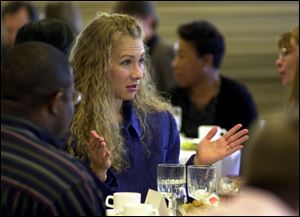
Biracial life bittersweet, author says
11/2/2000
As a biracial person, `I often felt alone and misunderstood,' Elizabeth Atkins Bowman tells faculty and staff members at Bowling Green State University.
BOWLING GREEN - Author and journalist Elizabeth Atkins Bowman said she lives in two worlds, and she explained how those worlds - one white and the other black - has been what she called a “blessing and a burden.”
Mrs. Atkins Bowman told a capacity-filled room at Bowling Green State University's Offenhauer Hall yesterday that she could not escape the labels of race and the lonely feelings of not fitting in many times in her life.
Born to an African-American mother and white father in the Detroit area, Mrs. Atkins said her fair skin and blond hair allowed whites to feel at ease with her. But those attitudes, she added, often changed swiftly when they found out she was biracial.
She said she remembered attending parties with black friends and being criticized by black females because of her looks. Mrs. Atkins Bowman said her times as a University of Michigan student were the toughest.
She said it was a time of great racial tension on campus and she and other biracial friends seemed caught in the middle.
“There was no place where I could be with both my white friends or my black friends,” Mrs. Atkins Bowman said. “I often felt alone and misunderstood.”
Mrs. Atkins Bowman, the author of two novels - White Chocolate and Dark Secrets - said part of the interest in biracial people today has come from the explosion of biracial children.
“From 1970 to 1990, the rate of interracial births has quadrupled,” said Mrs. Atkins Bowman, a former Detroit News reporter. “The numbers will probably grow even more with the next census. Our numbers are growing, our voices are getting louder, and our opinions are being taken more seriously.”
Mrs. Atkins Bowman, though, said she didn't support the efforts for a biracial box on the U.S. Census form because it created more confusion than answering specific questions about being biracial. She said she was pleased with the compromise reached by the bureau, allowing biracial people to check more than one box.
She said her position cost her numerous friends and supporters.
“There are people in the biracial community who won't even talk to me or acknowledge my existence,” Mrs. Atkins Bowman said.
She said the notoriety of Professional Golf Association star Tiger Woods, who is African-American and Thai, has brought positive attention to biracial people and made it a topic of conversation.
“Tiger did get a lot of criticism at first for wanting to claim [both sides of his heritage],” Mrs. Bowman-Atkins said. “The most important thing was that it got people talking about it and what it really means.”
After her speech, Mrs. Atkins Bowman said she wanted people to take off their racial armor and look at each other from the inside out.
“I want to get people to look beyond labels and skin color,” Mrs. Bowman said. “People spend a lot of time attaching attitudes to those labels.”
Several biracial people in the audience said Mrs. Atkins Bowman's message related to the majority of people who live with dual races.
“Her speech was phenomenal,” said Kristin Combs, 19, a sophomore biracial student. “Every story she told I agreed with and had happen to me. My mother is white, and I grew up in a white community. I didn't even know my father was black until I was 12. I'm learning more everyday about my heritage.”
Another biracial female, Meghan M. McLaughlin, 20, a junior, said Mrs. Bowman affected her point of view about the multiracial box on census forms.
“It was like she was telling my story up there,” Miss McLaughlin said. “I used to feel strongly about the [multiracial] box. But after listening to her, she made a lot of good points, and I don't feel as strongly about it anymore.”